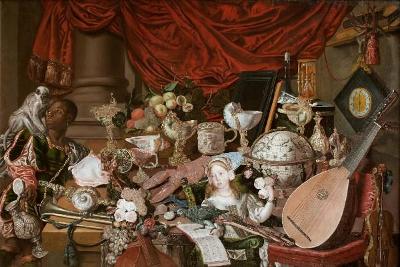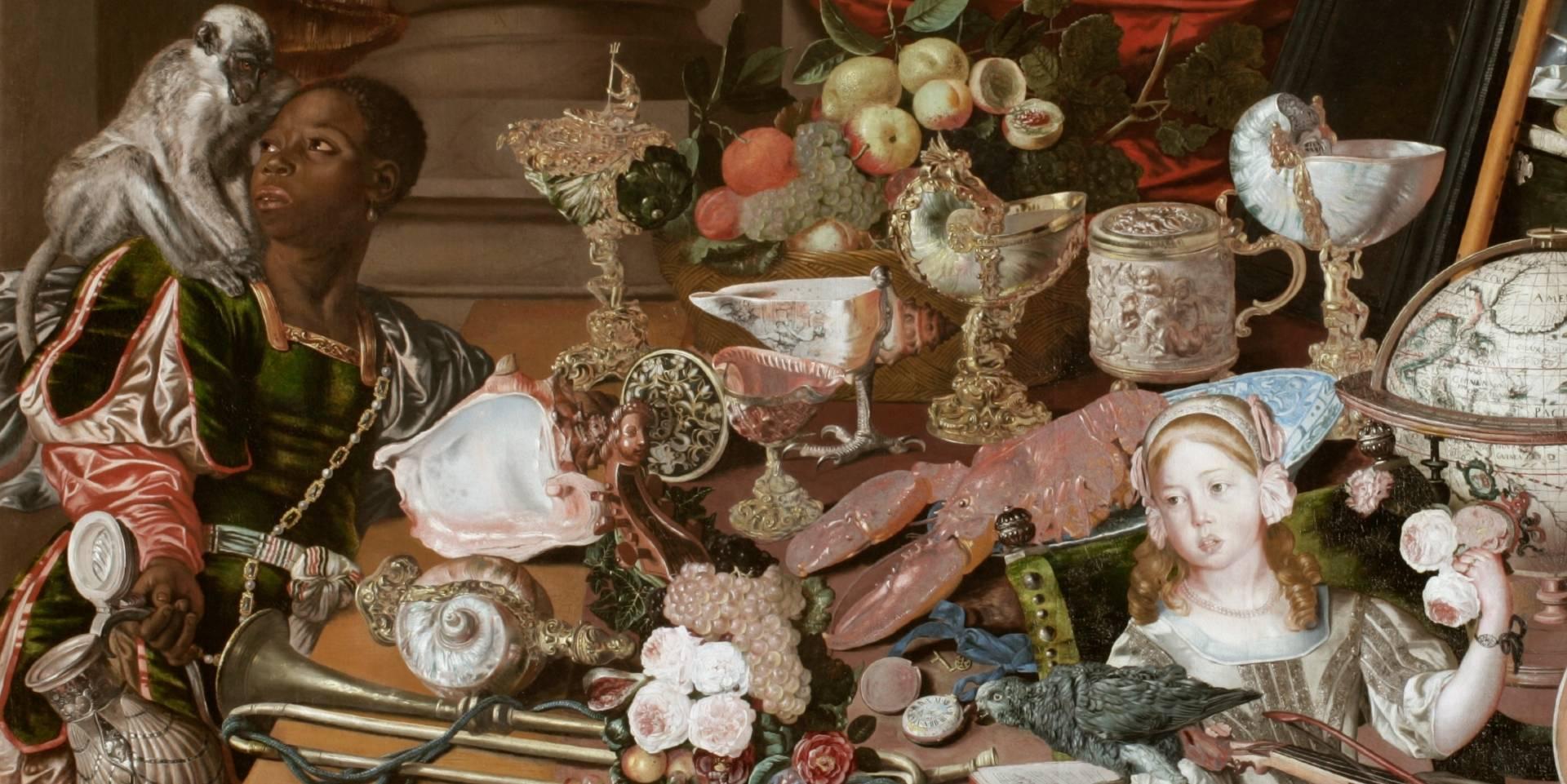Explore the painting

'The Paston Treasure' records a small part of the collections of the Paston Family, acquired during the 17th century by Sir William Paston and his son Sir Robert.
Many of the objects, such as the fruit and flowers, musical instruments, clock and watch, hourglass, pipe and candle frequently feature in still life 'vanitas' paintings to express the passing of time and the frailty and transience of human life. Other elements, such as the mirror, terrestrial globe, luxurious artefacts, exotic fruit and creatures are often included in 'vanitas' paintings to suggest the futility of worldly things and physical beauty when man's true focus should be on God, spiritual purity and heaven. This painting seems as much a celebration of the family's treasures as a recognition that these gorgeous worldly objects will not stop the passing of time, the fading of physical beauty or the need for the family's members to concentrate on their souls and the afterlife.
In this 'vanitas' painting many of the objects are not merely symbols but records of actual objects the family owned, which still exist. Explore the painting in detail below to find out more.

Details
Hourglass and candle

Some parts of this work are typical of a mid-17th century Dutch still-life. Portrayals of gold and silver treasures representing worldly wealth are interspersed with reminders of death and the passing of time, like this hourglass and the recently snuffed-out candle.
Bull's mouth helmet shell cup

Most vanity still-life paintings contain one or two gilded objects which are artists' stock items, included for their symbolism. In 'The Paston Treasure', we know that five of the artefacts depicted survive, and are now in collections around the world. From surviving inventories, we know that these treasures were once owned by the Paston family.
Watch

In 'The Paston Treasure' symbols of time like this watch may refer specifically to family circumstances. It is thought that William Paston commissioned the painting near the end of his life. By 1662 all but one of his six children had died. He had quarrelled with Robert, his only surviving son. William must have been well aware of life's fragility and of the emptiness of worldly riches, one of the artwork's key messages.
Little girl

Until recently, it was thought this little girl could be Mary Paston (c.1664-1676), Robert's second daughter, who died of smallpox aged about twelve.
However, the picture was probably painted no later than the first half of the 1660s. Nothing portrayed within it, including the girl's dress and hairstyle, can be dated any later. She may be Robert's eldest daughter Margaret (1652-c.1723). Her grandfather William left her a generous legacy, suggesting she was a particular favourite - another 'Paston treasure'. Read more about Margaret on the Norwich Castle blog.
Song book

The song has been recently identified as a lament entitled Charon O Charon heare a Wretch opprest by Robert Ramsey (c.1595-1644), a composer whom William Paston may have known. Did he ask that his granddaughter be painted singing this song to lament his death?
Painted-out figure

X-rays and Macro-XRF imaging undertaken on 'The Paston Treasure' have revealed the shadowy form of a woman at the upper right-hand side of the picture, above the curve of the red tassel.
Scientific analysis shows that this area was painted three times in relatively quick succession. The first version showed a large dish, the second a three-quarter length lady in a red dress, and the last was the diamond-shaped clock we see today.
Who was this woman, and why was she painted out? If she was a real person, the most likely candidate is Lady Margaret Paston (d.1669), William Paston's second wife, whom he married in 1640.
Clock

William died on bad terms with his son Robert, whose spending habits he criticised. Many family treasures were bequeathed instead to William's wife Margaret, whom Robert disliked, including a large silver dish. This may be the dish seen in the first version of the painting.
If the picture was unfinished when William died, did Robert have his stepmother painted out, and the silver dish substituted for the clock? This area is the least carefully painted part of the canvas, as if the artist's, or patron's, time and patience were running out.
Young man

This young man offers no clues to his identity. He may be a purely symbolic reference to William Paston's travels, but he is painted realistically. Although there is no record, the Pastons could have bought him as an enslaved servant and had him painted as an exotic 'possession'.
At this date, when Black and white people are portrayed together, the former almost always look deferentially up at the latter. Not so here: this young man is placed higher than the girl, and they are not interacting.
Atalanta shell cup

This cup, one of the five objects known still to exist, was owned by the Buxton family, who also owned 'The Paston Treasure'. It has always remained with the painting proving that there were real, not just symbolic, objects in this picture.
The original shell that appears in the painting was a Strombus gigas, a type of conch found in the Caribbean. The shell on the cup as it is today is a replacement - a larger and rarer conch, Strombus goliath, from Brazil.
Shell cup

It was fashionable in the 17th century to mount rare shells in precious metal mounts. They were intended as decorations, not for use. The shells were expensive curiosities brought to Europe by the East India Company, which was becoming involved in global trade and colonisation.
Silver flagon

This flagon, or livery pot, is one of a pair, both of which survive in the Metropolitan Museum of Art, New York. Both flagons bear the arms of Chief Justice Sir Edward Coke (1552-1634) and Bridget Paston, whom Coke married in 1582.
The choice of cockle and scallop shells is probably significant, since cockle, or in French, coquille, is a pun on the name 'Coke'. Around 1642-43, at the start of the Civil War, some of the Coke silver was sold. This may be when the flagons became part of the Pastons' collection.
Rijksmuseum shell cup

This cup is now in the Rijksmuseum, Amsterdam. It is one of three nautilus shell cups depicted here, although the Pastons owned more than fifty. In the painting there is a Paston coat-of-arms visible inside the cup, for which one section of the nautilus has been cut away. The real cup now has a replacement shell.
Prinsenhof shell cup

This cup is now in the Museum Het Prinsenhof, Holland. It is the only item in The Paston Treasure attributable to a known maker, Nicolaes de Grebber of Delft, and datable, to 1592. The Paston coat-of-arms is engraved inside the shell, although invisible in the painting.
A satyr forming the cup's stem holds a songbook, upon which music is engraved, legible on the cup itself. The song, by composer Clemens non Papa (c.1510-56), was well-known in 1592. His name is another form of 'Clement', suggesting that the cup was commissioned by Clement Paston.
Pearl flask

This flask was formed from the shell of the turbo marmoratus snail. In its natural state, it has a matte green-white surface, which has been scraped off to reveal the pearly layer underneath. Several shells were needed to make one vessel, adding to their expense and high status.
Gujarat in India was the main centre of production for vessels like this. They were mostly exported via the Portuguese East India Company and the silver-gilt mounts were usually added in Europe. The Pastons could have purchased it from many sources, including London or Amsterdam.
Silver tankard

During the Civil War, Robert Paston sent large sums of money to support Charles II in exile. Like many Royalists, the Pastons were also ordered to give quantities of silver to Parliament, which needed money to pay its army. Tankards like this one were melted down for coin.
Robert remained close to Charles II, eventually becoming Earl of Yarmouth, but his finances never recovered. The family collection began to be sold off, including 'The Paston Treasure' in 1709. This was not enough to pay their debts, and the second Earl died bankrupt.

